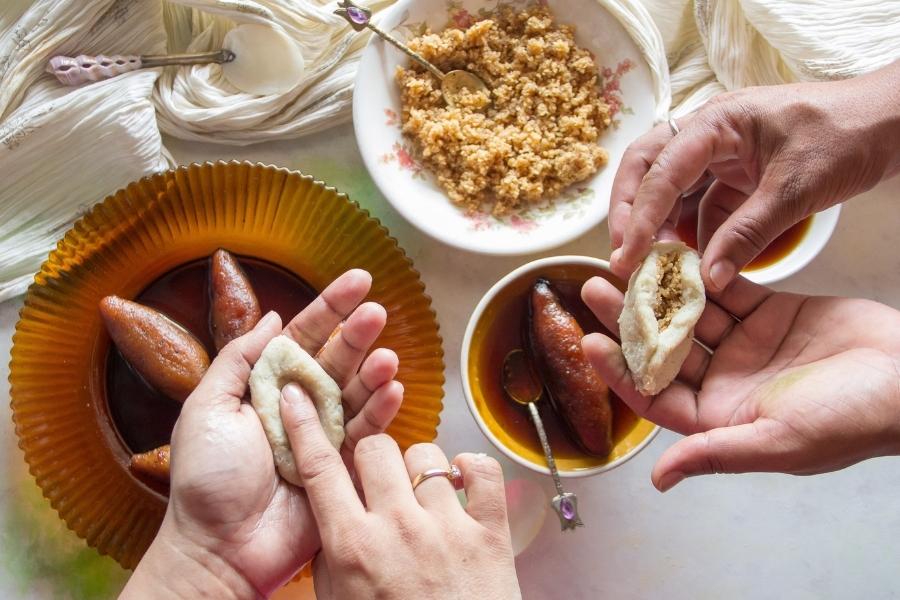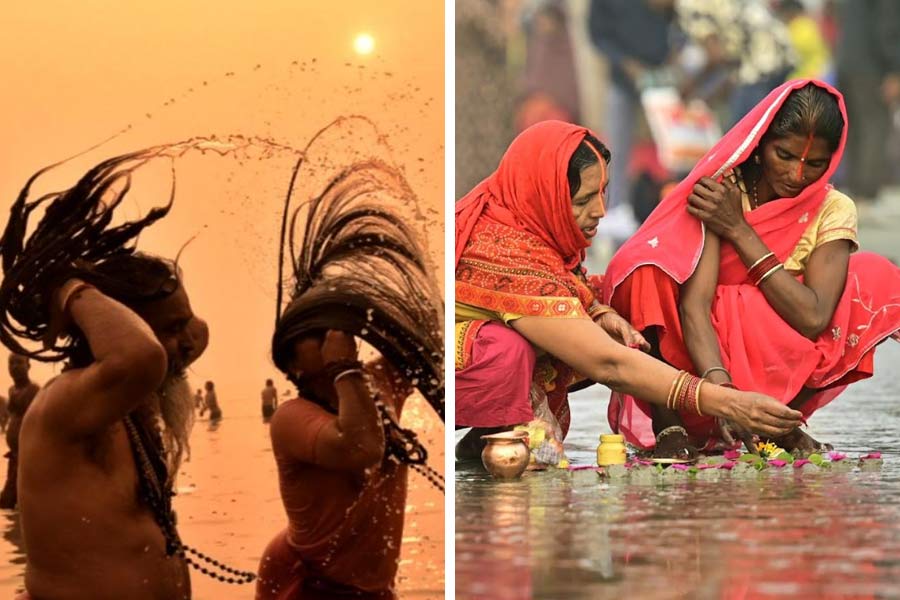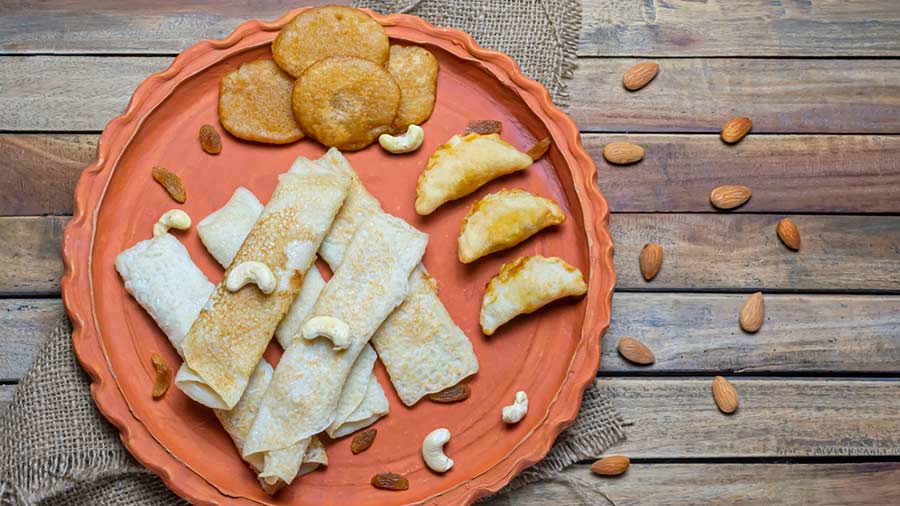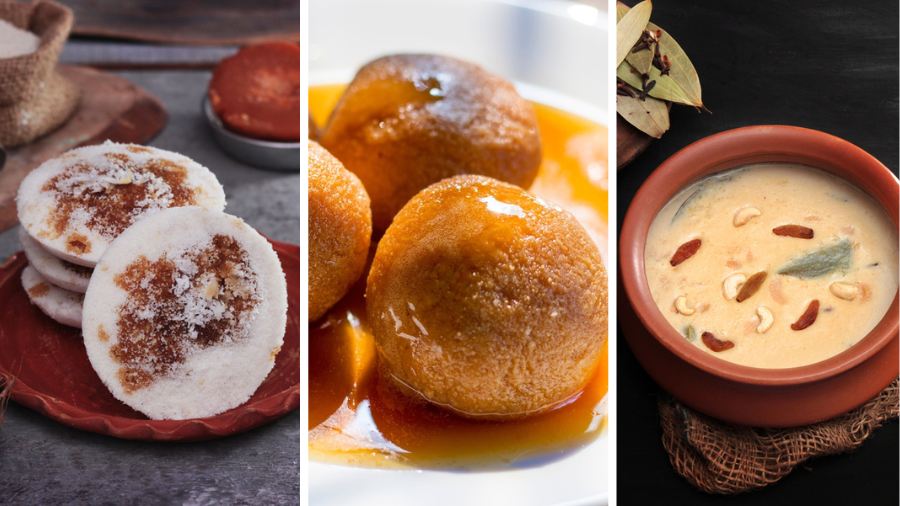Come Poush Sankranti, and the sweet smell of coconut and jaggery wafts out of home kitchens as pithe, patishapta and payesh are prepared. The wait for the first pithe, or the first taste of payesh, feels like an eternity — but when it finally is served, it feels like a warm hug that touches the soul. Nostalgia is greatly entwined with Poush Sankranti. Ask anyone in Bengal about their favourite Sankranti delicacy, they would take the name of the dish, adding
‘Amar thakurmar/didar/maa-er haater banano (made by my grandmother/mother)’. Taking a joy ride on this nostalgia trip, My Kolkata spoke to four food influencers representing Bengal to know about their favourite pithe memories and recipes.
‘Hot pithes represent nostalgia’
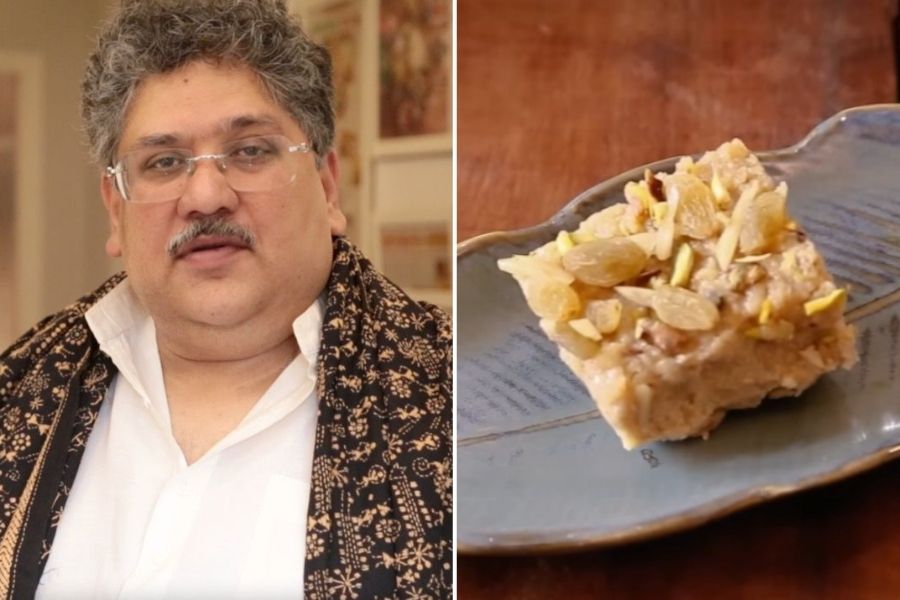
Subhajit Bhattacharya's Chandra Kaath or Chandan Kaath Pithe
For Subhajit Bhattacharya of Lost and Rare Recipes, pithe brings back childhood memories when he relished hot Patishapta and Gokul Pithe made by his mother and maternal grandmother. “My Poush Sankranti memories revolve around enjoying hot Patishapta with coconut or kheer filling. And the Patishaptas in our house were relished with a generous amount of kheer on top. This added a decadent taste to it. Another nostalgic delicacy from my childhood is the Gokul Pithe. My mother learnt it from my grandmother and I learnt from her.” For this pithe, a filling is made with coconut and kheer. It is a dense filling that is given the shape of small discs. which are dipped in a batter of milk, sooji and maida, fried in ghee and then put into sugar syrup. “I remember always enjoying this hot. Pithes at our house were mostly relished hot,” added Bhattacharya.
A food content creator and home chef, Bhattacharya has noticed that the culture of making pithe at home on an unoon (clay oven) has shifted to the sweet shops that sell this delicacy. “Pithe represents nostalgia for us. Nowadays, people are busy and therefore many homes prefer buying it from the shops. In the process, there are many kinds of pithes that people don’t make anymore. You can’t call them forgotten, because some families still make it. But maybe, because of the tedious process, many people don’t make it anymore.”
Talking about a unique pithe, he recalled trying Chandra Kaath Pithe in Bangladesh and it instantly became his favourite. “When I started travelling, I learnt about different kinds of pithes that are both delicious and beautiful. I would like to mention three of them — Dolla Pithe, Moong Pakon Pithe and Chandra Kaath or Chandan Kaath Pithe. Dolla Pithe is made with ripe banana, coconut and rice flour. Jaggery is poured over the little balls. It is a flameless recipe from Bangladesh. The Moong Pakon Pithe is made in various parts of rural Bengal and for this Moong lentil is used with maida and coconut. The pithes are given different shapes. My uncle’s ancestral house was in Mymensingh. There his mother made this and it is an elaborate recipe. This dish is made with milk, khoya kheer, maida, coconut, jaggery and chopped cashews, pista and almonds. This is one pithe I would urge everyone to try.”
The variations may surprise many
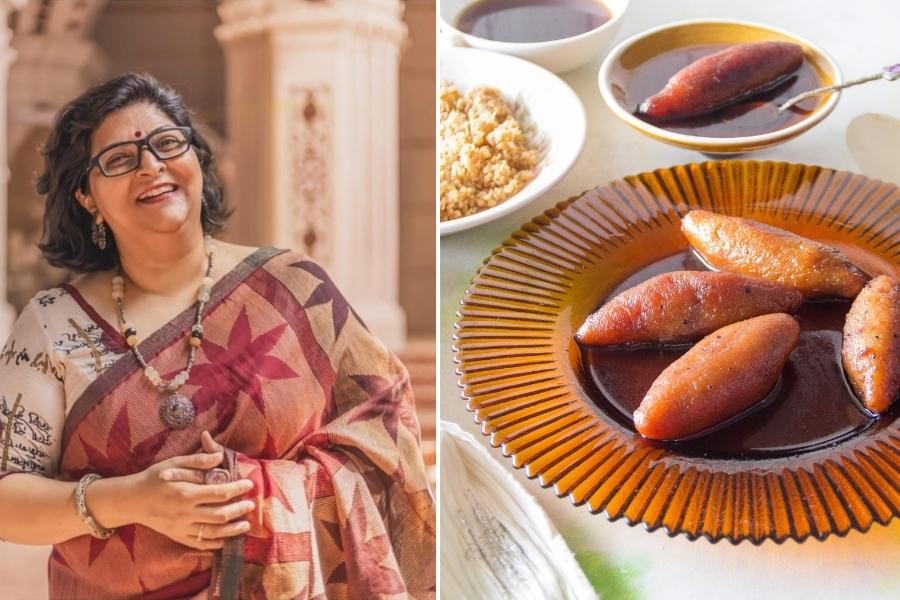
Madhushree Basu's Bengali-style Roshopuli
For Pikturenama’s Madhushree Basu, pithe makes her think of Patishapta, especially the ones her grandmother made. “Patishapta is the easiest to make and pithe making in most households begins with this. I remember the moist and soft Patishaptas made by my grandmother on an unoon and iron tawa. They were never dry and the balance of the ghee and gur was just perfect.” But after marriage, Ranga Alur Roshopuli made it to Madhushree’s list of favourite pithes. “I learnt Ranga Alur Roshopuli from my mother-in-law, who made it for us on every Sankranti. It became a family tradition to make and eat this together,” said the lady behind Pikturenama, a multi-media food channel.
Check out the recipe of Ranga Alur Roshopuli here.
Every household has its unique and favourite Poush Sankrant recipes. The variations of pithe-pulis may surprise many. Talking about a unique pithe, Madhushree mentions the savoury Sabji Pithe — “Sabji Pithe is quite unique. I haven’t seen many people do it. My grandmother would grind the rice flour at home and strain it through a dhoti cloth. The fine rice flour was then mixed with water and veggies like carrots and peas. The batter was then put into a shora and steamed on an unoon. I, too, do it the same way and will be doing it again. It is something that you have to have hot for breakfast or evening snack.”
When asked if she misses any ‘forgotten’ pithe? Madhushree said, “In the age of social media, nothing is forgotten. Many pithes are not made any more in certain households because they are time consuming. One such version is the Niranjan Pithe, which is like a Chushi Pithe, but made with Sooji.”
Ancestral recipes to the rescue
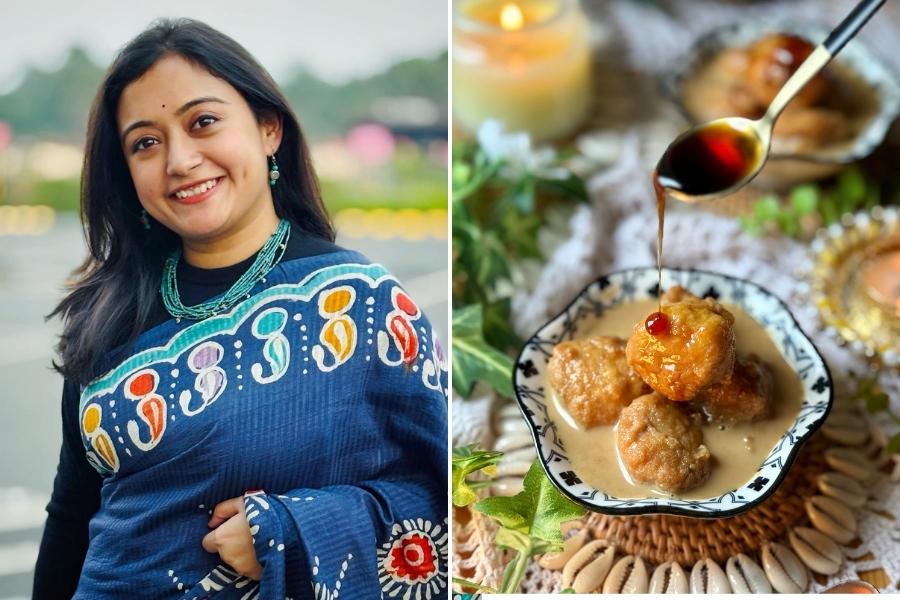
Arpita Das's Kheer Bora
Although she lives out of the country, Arpita Das of Weekend Flavours makes sure she enjoys the flavour of her land in the heart of Singapore. All she does is call her mother and ask for the recipes! For Arpita, most pithes she makes are from her mother or grandmother’s recipes. When she hears of pithe she thinks of Jhal Pulipithe: “This is something I really enjoy. Since childhood, I’ve seen my mother and grandmother make it along with other types of pithe. The stuffing inside the puli is typically made from a mixture of potatoes, cauliflower, green peas, and spices. It is not eaten with nolen gur. This pulipithe is enjoyed as it is.”
Like many families, Arpita’s family love Kheer Bora, which is similar to Rosh Bora, but made with kheer. The content creator explained, “Many of us make Rosh Bora as a type of pithe, usually prepared with biulir dal and dipped in sugar syrup or nolen gur. The biulir dal is soaked, ground into a paste, mixed with fennel seeds, fried, and then added to the syrup. However, one of my aunts prepares it differently by boiling it in milk or kheer instead of sugar syrup or nolen gur. I find this version quite unique and delightful.”
One pithe that Arpita misses is Monoranjan Pitha that is not commonly made anymore. The ingredients include semolina (suji), coconut, khoya kheer, milk, sugar, ghee, and cardamom. The semolina, coconut, and khoya kheer are fried in ghee and then boiled in milk. “While it was more commonly prepared in the past, nowadays, during pithe-making occasions, dishes like patisapta, pulipithe, soruchakli, and bhajapithe are typically made. In many places, Monoranjan Pitha is also known as Rosopuli. Although I’ve never made it myself, I definitely want to try. I’ll learn the recipe from my mother and give it a try soon,” summed up Arpita.
Pithes must be shared with family
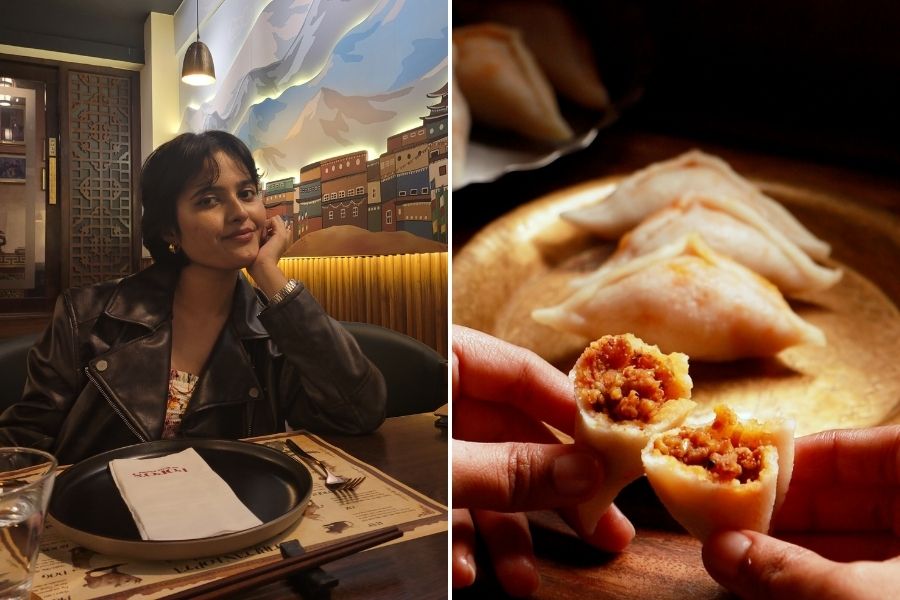
Binita Das's Torkari Pithe
For Binita Das of Just Another Cook, pithe is about family time. “If you ask me about pithes, it is the picture of a very chilly evening when four of us — my father, mother, sister and I are sitting together on our kitchen floor and my parents are shaping the pithe and we are waiting for them to finish the steaming. It's mostly the puli-pithe, sheddho pithe, where you shape them and steam them and then we eat. We are always eager to see different shapes of pithes and that's what interested me when we were little,” recalled Binita. Binita recently has started sharing her family recipes in a reel series. Recently she uploaded a spicy puli pithe recipe that she thought was unique to her family, but soon realised it was something other people made too. “I uploaded the recipe and I saw that it's kind of a normal practice for other households as well. Maybe it's less popular. But I still like to think that it's sort of our speciality. It's my mom's speciality.
She makes this extremely spicy puli-pithe and she makes a cauliflower and potato filling and then she stuffs it inside the sheddho pithe and then she steams it. Basically this is it, a very spicy, savoury version of the pithe. Unique because it's different as most pithes are sweet. So savoury pithes stand out always and it's my favourite.”
